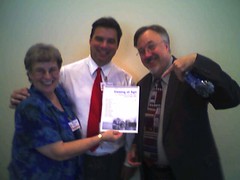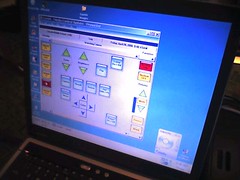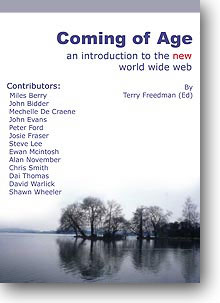This is a moblog, typed in real time during the event. Please forgive misspellings and awkward text.>
It’s TechForum 2006 in Chicago, and Hall Davidson is doing the keynote. The speech title is “The World is Shrinking”. He just said that one thing that is definitely shrinking is the distance between imagination and reality. This is so true, and I’ve thought about this a lot. But I’ve never heard the idea expressed so succinctly.
He also says that it’s pretty cool to be an educator right now. We are more in touch with the future than anyone else, because we are in daily contact with the people who will be inventing the future. We (many of us) know what podcasting is. Most corporate workers do not! Not sure that’s true, but I believe that the idea is correct. We work with the future.
I’ve heard this address before, and I’ve blogged it before. But one thing that suprised me was when Hall asked what web site gets more than two and a half times the traffic of Google. The answer was Myspace. In MySpace, children are important. Learning is important. How do we make learners just as important?
Wow! Discovery now has a home version of streaming video, called Cosmo. No surprise, bound to happen. But a school in Evanston, Illios will be selling it to homes as a fund raiser. Kids selling media, to raise money to learn. To cool for school!
I must say that this is a rich conference. I have to choose a session to go to next, and my choices are Laptop Learning, Games for Education, 21st Century Professional Development, and Data Security and student safety. I’ll let you know where I went.
It should be little surprise that I went to the gaming session. I walked in a little late, and the speaker was saying that they are now beginning to get data that indicates more powerful learning through video gaming.
He then said that the mother-ship of instructional gaming is “Active Engagement”. Students need to talk about the experience before, during, and after the game. The learn, by talking about it, not by playing the game alone. I suspect that the kids are learning, but the do not know that they are learning, unless they talk about it. This is an important distinction, I suspect.
The speaker (Bill MacKenty) said that when he is selecting off-the-shelf games for his classroom, he picks the game first and then figures out how to use it for learning.
The next speaker is Corbett Beder. His angle seems to be helping students to learn by empowering them to design their own games.
The question and answer session was not very eventful. The big question was asked first, what about violence. MacKenty said that he was super sensative to violence. He dosn’t go there. He also said that kids understand context, that they can see the violence within the context of the games plot, and that it is not blatant violence.
One of the most interesting ideas I heard was about a language teacher who is using The SIMS to teach German. It’s about context.
 One treat was making the connection between the Shawn Wheeler who was to pick me up at the Phoenix airport last night and the Shawn Wheeler who contributed to Freedman’s Coming of Age book. Here’s a picture of Shawn and me and ASU professor, Peggy Davis.
One treat was making the connection between the Shawn Wheeler who was to pick me up at the Phoenix airport last night and the Shawn Wheeler who contributed to Freedman’s Coming of Age book. Here’s a picture of Shawn and me and ASU professor, Peggy Davis.

 I’m copying and pasting this in from Ewan Macintosh’s weblog,
I’m copying and pasting this in from Ewan Macintosh’s weblog,  I think that if curiosity, an intrinsic need to communicate, and future orientation are sources of energy that we can depend on to power flat classroom learning engines, then to some degree, the fuel that powers that energy is heritage. I mean this in the broadest terms possible, not merely the historical and cultural foundations of our lives, but also our environmental, economic, and media experiences.
I think that if curiosity, an intrinsic need to communicate, and future orientation are sources of energy that we can depend on to power flat classroom learning engines, then to some degree, the fuel that powers that energy is heritage. I mean this in the broadest terms possible, not merely the historical and cultural foundations of our lives, but also our environmental, economic, and media experiences.  In 1989, I presented at my first educational technology conference, the
In 1989, I presented at my first educational technology conference, the